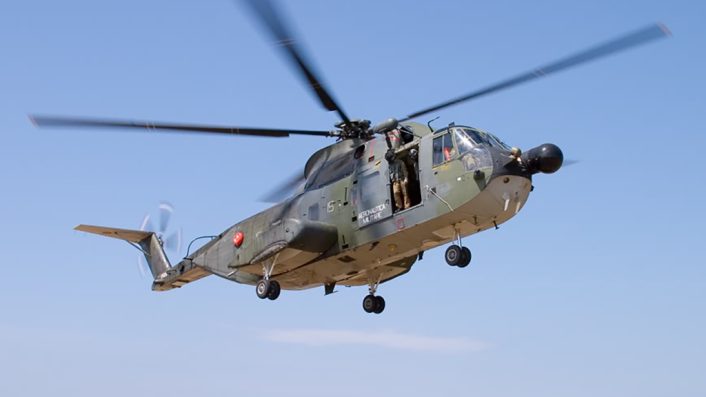The U.S. company procured 26 HH-3F Pelican helicopters retired by the Italian Air Force 10 years ago.
Clayton International, a leading player in helicopter maintenance, repair, and overhaul (MRO), specialized in refurbishing Sikorsky helicopters, has scored a major acquisition, buying up all the HH-3F helicopters previously owned by the Aeronautica Militare (Italian Air Force). The deal includes 26 helicopters along with a big stash of spare parts and components. Out of these, 20 aircraft are heading to Clayton’s facility in Peachtree City, Georgia.
The HH-3F, originally designed by Sikorsky in the 1970s for the U.S. Coast Guard, was later built under license by Agusta in Italy. A variant of the Sikorsky S-61R, the Pelican boasted impressive SAR (Search and Rescue) capabilities and versatile cargo configurations. Its spacious cabin (26 feet long, 78 inches wide, and 75 inches tall) provided ample room for various operations; key SAR features included a 600-pound rescue hoist with a 240-foot cable, a Nightsun searchlight for nighttime operations, and a forward-looking infrared (FLIR) camera for target spotting. A detachable rescue platform enabled water landings, while fast-rope deployment allowed rapid access in emergency scenarios. The aircraft’s hydraulic rear ramp was functional on the ground, in flight, or even while floating, complemented by an auxiliary flotation system for enhanced stability in water. Advanced search/navigation radar and SAR-specific avionics completed its rescue-focused design. The basic interior setup accommodated 10 passengers or six medical litters.
For utility and cargo tasks, the aircraft could transport 26 troops with foldable, seat-belt-equipped seating or carry up to 15 patients with two medics for emergency evacuations. It offered an 8,000-pound external cargo capacity and a robust rear ramp that facilitates loading vehicles or oversized cargo. The durable cabin floor supported 200 pounds per square foot, with options to handle heavier loads using pallets or shoring. Additionally, the nose gear could “kneel” to improve vertical clearance for cargo loading via the aft ramp.

In the 1970s, the Italian Air Force chose the HH-3F to replace the HU-16 Albatross amphibian aircraft and inducted it into active service in 1977. The twin-engine, five-blade helicopter was used in search and rescue operations, medical evacuation, transport missions or support for special forces, serving with the 15° Stormo (Wing) out of the rescue centers at Rome-Ciampino (later Pratica di Mare), Rimini (later Cervia), Trapani and Brindisi (then Gioia del Colle).
The first SMI mission involving HH-3F helicopters took place during Operation Giotto in 2001, where the “HHs” flew at 1,000 feet altitude, five miles off the coast, at night, using night vision goggles. Then, the Pelicans took part in several other real missions, like those dubbed “Lavinium”, “Aventino”, “Columbus”, and “Jupiter”, intercepting small aircraft unresponsive to air traffic control calls and flying at low altitude. During the NATO-Russia Summit in May 2002, an HH-3F engaged in an SMI mission intercepted an aircraft at 160 knots (later deemed harmless). For such missions, the helicopter was equipped with side and ramp machine guns along with large displays to show the intercepted aircraft instructions like “TURN LEFT”, “TURN RIGHT,” “FOLLOW ME” or “LAND.”

When the ItAF retired it, on Sept. 26, 2014, the Pelican had logged 185,000 flying hours and 7,000 saved lives in Search And Rescue missions (and C-SAR ones) during its 37 years of active service, in Italy and abroad. The HH-3F took part in Operation Restore Hope in Somalia in 1992 (789 missions for 820 flight hours), and was deployed to the former Yugoslavia, Albania, Kosovo and Iraq from 2003 to 2006, as part of Operation “Antica Babilonia”.
The Italian Air Force replaced the HH-3F helicopter with the HH-139A multirole helicopter.

Future plans
Clayton plans to breathe new life into these helicopters, targeting operators interested in an affordable, multi-engine, 10-ton aircraft with plenty of cabin space.
The choppers can serve multiple missions and can be pitched to a wide variety of potential operators, both civilian and military ones.

We’re talking about a 22,000-pound twin-engine beast with a range of 750 nautical miles. It’s got a spacious cabin and a rear ramp that make it perfect for all kinds of missions, from search-and-rescue (SAR) to cargo hauling. The helicopter features a back ramp (similar to the one of the CH-47 Chinook) that can be particularly useful for multitude of things. Oh, and the HH-3F is amphibious too, which means it’s right at home handling offshore jobs.
Some operators fly the S-61L and S-61N, the civilian variant of the naval SH-3, with a longer fuselage than the S-61R/HH-3F, in the firefighting role. There are chances the former Italian HH-3Fs can be converted to carry out firefighting missions too.










